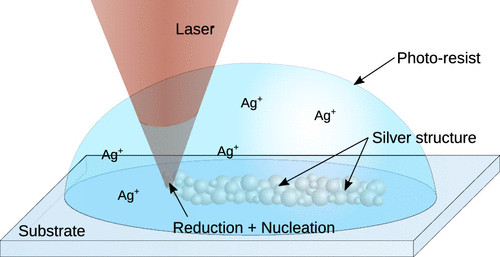当前位置:
X-MOL 学术
›
ACS Appl. Nano Mater.
›
论文详情
Our official English website, www.x-mol.net, welcomes your feedback! (Note: you will need to create a separate account there.)
Simulation Model for Direct Laser Writing of Metallic Microstructures Composed of Silver Nanoparticles
ACS Applied Nano Materials ( IF 5.9 ) Pub Date : 2021-08-24 , DOI: 10.1021/acsanm.1c01514 Thomas Palmer 1 , Erik H. Waller 1, 2 , Heiko Andrä 1 , Konrad Steiner 1 , Georg von Freymann 1, 2
ACS Applied Nano Materials ( IF 5.9 ) Pub Date : 2021-08-24 , DOI: 10.1021/acsanm.1c01514 Thomas Palmer 1 , Erik H. Waller 1, 2 , Heiko Andrä 1 , Konrad Steiner 1 , Georg von Freymann 1, 2
Affiliation

|
Three-dimensional metallic microstructures find applications as stents in medicine, as ultrabroadband antennas in communications, in micromechanical parts, or as structures of more fundamental interest in photonics like metamaterials. Direct metal printing of such structures using three-dimensional (3D) laser lithography is a promising approach, which enables the fabrication of 3D structures with sub-micron-sized features. Yet, this fabrication technique is not extensively applied, as fabrication speed, surface quality, and stability of the resulting structures are limited so far. To identify the limiting factors, we investigate the influence of light–particle interactions and varying scanning speed on heat generation and particle deposition in direct laser writing of silver. We introduce a theoretical model which captures diffusion of particles and heat as well as the fluid dynamics of the photoresist. Chemical reactions are excluded from the model, but particle production is calibrated using experimental data. We find that optical forces generally surmount those due to convection of the photoresist. Simulations predict overheating of the photoresist at laser powers similar to those found in experiments. The thermal sensitivity of the system is essentially determined by the largest particles present in the laser focus. Our results suggest that to improve nanoparticle deposition and to achieve higher writing speeds in metal direct laser writing, strong optical trapping of the emerging particles is desirable. Furthermore, precise control of the particle size reduces the risk of spontaneous overheating.
中文翻译:

由银纳米粒子组成的金属微结构的直接激光写入模拟模型
三维金属微结构可用作医学中的支架、通信中的超宽带天线、微机械部件或光子学中更基本的结构,如超材料。使用三维 (3D) 激光光刻直接金属打印此类结构是一种很有前景的方法,它能够制造具有亚微米尺寸特征的 3D 结构。然而,这种制造技术并未得到广泛应用,因为迄今为止所得到的结构的制造速度、表面质量和稳定性都受到限制。为了确定限制因素,我们研究了光-粒子相互作用和不同扫描速度对银的直接激光写入中的热量产生和粒子沉积的影响。我们引入了一个理论模型,该模型可以捕捉粒子和热量的扩散以及光刻胶的流体动力学。模型不包括化学反应,但使用实验数据校准粒子产生。我们发现,由于光刻胶的对流,光学力通常会超过那些。模拟预测光刻胶在与实验中发现的激光功率相似的激光功率下会过热。系统的热灵敏度基本上由激光焦点中存在的最大粒子决定。我们的结果表明,为了改善纳米颗粒沉积并在金属直接激光写入中实现更高的写入速度,需要对新兴颗粒进行强光捕获。此外,对粒度的精确控制降低了自发过热的风险。
更新日期:2021-09-24
中文翻译:

由银纳米粒子组成的金属微结构的直接激光写入模拟模型
三维金属微结构可用作医学中的支架、通信中的超宽带天线、微机械部件或光子学中更基本的结构,如超材料。使用三维 (3D) 激光光刻直接金属打印此类结构是一种很有前景的方法,它能够制造具有亚微米尺寸特征的 3D 结构。然而,这种制造技术并未得到广泛应用,因为迄今为止所得到的结构的制造速度、表面质量和稳定性都受到限制。为了确定限制因素,我们研究了光-粒子相互作用和不同扫描速度对银的直接激光写入中的热量产生和粒子沉积的影响。我们引入了一个理论模型,该模型可以捕捉粒子和热量的扩散以及光刻胶的流体动力学。模型不包括化学反应,但使用实验数据校准粒子产生。我们发现,由于光刻胶的对流,光学力通常会超过那些。模拟预测光刻胶在与实验中发现的激光功率相似的激光功率下会过热。系统的热灵敏度基本上由激光焦点中存在的最大粒子决定。我们的结果表明,为了改善纳米颗粒沉积并在金属直接激光写入中实现更高的写入速度,需要对新兴颗粒进行强光捕获。此外,对粒度的精确控制降低了自发过热的风险。

























 京公网安备 11010802027423号
京公网安备 11010802027423号